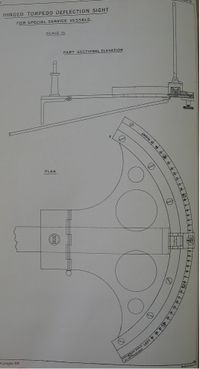Torpedo Deflection Sight
As the war developed, the Royal Navy was not happy with its Torpedo Directors, which combined calculating functions based on the director triangle with the sighting function. It devised a family of Torpedo Deflection Sights of several Marks which sought to encompass only the simple task of sighting, leaving the task of calculating the director angle to external means.
Geometric Model
The deflection sights worked on the deflection triangle — that formed by the line-of-sight, the path of torpedo, and the line perpendicular to line-of-sight that passes through the point of impact. That last line is the Torpedo Deflection, or speed-across attributable to enemy motion.
The charm seen in such a geometric model is that for any given speed of torpedo, a single radial scale can be etched that converts torpedo deflection to the suitable director angle. This means a director's proper setting can be communicated quickly and according to a measure (enemy speed-across) that might be roughly guessed with some accuracy in an emergency.
Mark I
This was the name given to all A.W. directors converted to being deflection sight, and by the end of August, 1918, had been widely to tubes light cruisers "Attentive" and after and TBDs "E" class and after armed with RGF and RNTF heaters.
Mark II
The Mark III sights were line of sight directors modified to deflection sights. By August, 1918, they had been issued to destroyers for use on the bridge, except in "V" class and later which have T.D.S. Mark III in this position.
Mark III
This was the first purpose-built T.D.S., and was intended as a universal sight for use on light cruisers and destroyers. It featured a Clear Range Indicator mechanism on its spindle.
Mark IV Types
This was a family of periscopic sights for placement in armoured control positions of capital ships. The periscope would peep out through the slot while the operator enjoyed some measure of protection from gun blast. An open sight alongside was helpful in poor visibility conditions.
Mark V

The Mark V had just a single deflection ring, bearing the letter designation of a C in a circle, etched for the 26.75-27.25 knot setting of the 18-in Mark IV and the 14-in R.G.F. Mark X*.
By mid 1919, the 14-in torpedo tubes had been removed from the P Boat Class (1915), and so the T.D.S. Mark V was removed from them, leaving them only on the subset of the "S" class destroyers that carried 18-in tubes. Shortly thereafter, those ships would also lose their 18-in torpedos, leaving no vessels carrying the Mark V.[2]
Mark VI
This sturdy, foldable sight was intended for emergency use at fixed above water tubes on capital ships. It featured an integral clear range indicator mechanism.
Mark VII
These periscopic sights could look out through the horizontal view slot of an armoured space on a battleship or battlecruiser and thus permit the operator to avoid gun blast.
Mark VIII
In mid-1919, this sight was still in the design stage. It was intended for principal control officers in capital ships. At its core, it would be similar to a T.D.S. Mark III, but with two clear arc indicators to show the arcs of 70 degrees to 110 degrees from friendly capital ships. A gyro ring worked by a milled head would permit fire to be ordered on any gyro bearing within the clear arc limits.[3]
Sight for Special Service Vessels

I believe this sight may have been intended for fitting in Q-ships.
Sight for C.M.B.s

Despite the name, this device is actually a torpedo deflection sight.
[TO BE CONTINUED - TONE]
See Also
Footnotes
Bibliography
- Template:BibUKARTS1915
- Template:BibUKHandbookOfTorpedoControl1916
- Template:BibUKARTS1917
- Template:BibUKARTS1918